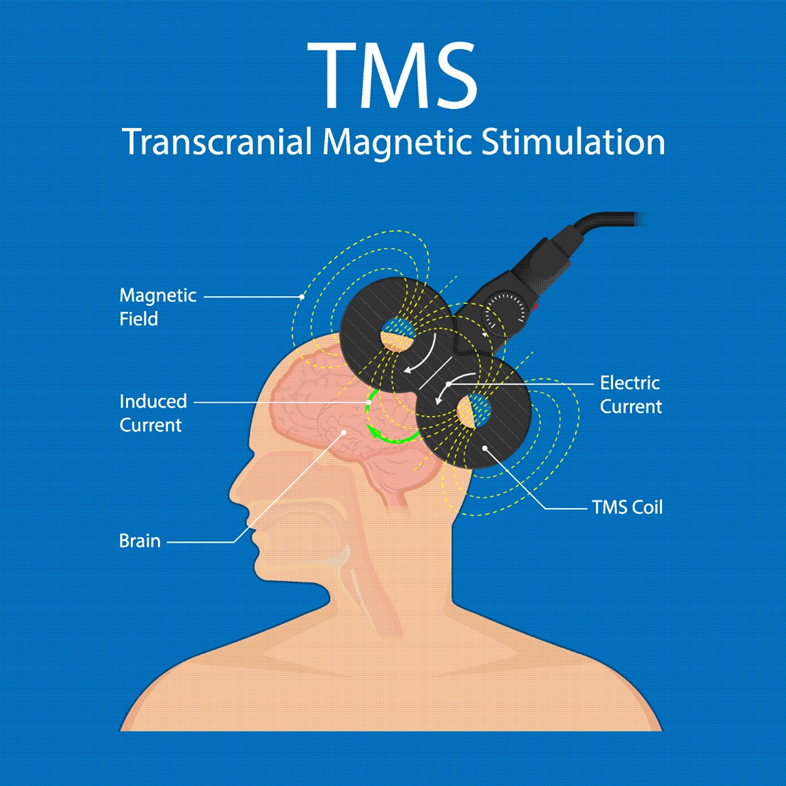What is TMS? Transcranial Magnetic Stimulation

Transcranial Magnetic Stimulation (TMS) is often hailed as a revolutionary treatment for depression and other mental health conditions. That’s right—because nothing says cutting-edge science like slapping a giant magnet on your head and hoping for the best. It’s non-invasive, doesn’t require medication, and has been FDA-approved, which must mean it’s foolproof… right? Well, let’s take a closer look before you sign up for your mind-zapping journey.
If you’re someone who doesn’t know the difference between a Psychiatry and Psychology then you might want to click on that link first. Just saying, TMS is a million steps ahead for you.
How Does TMS Work?
TMS uses electromagnetic fields to stimulate nerve cells in the brain, specifically targeting areas associated with mood regulation. Imagine trying to fix your Wi-Fi by smacking your router—except the router is your brain, and instead of your palm, it’s a high-powered magnetic coil. A device is placed against your scalp, delivering repetitive magnetic pulses that are supposed to activate (or, let’s be real, confuse) your neurons into behaving better.
While we’re on the subject of How it works, here’s a blog on TMS when it didn’t work.
What is it Used For?
While its primary claim to fame is treating major depressive disorder (MDD), TMS has been thrown at a variety of conditions with mixed success, including:
Anxiety Disorders – Because clearly, a giant magnetic coil is the best way to calm down.
Obsessive-Compulsive Disorder (OCD) – FDA-approved for OCD, because if your brain doesn’t listen to logic, maybe it’ll listen to a magnet.
Post-Traumatic Stress Disorder (PTSD) – Early research suggests it might help, but you could also just get a support dog and avoid the zaps.
Chronic Pain & Migraines – Because why just have headaches when you can also induce them?
Addiction Treatment – Supposedly helpful for breaking cravings. But let’s be honest, if magnets cured addiction, we’d all be hanging out near the fridge more often.
The Pros and Cons
Pros:
Non-invasive – No surgery, anesthesia, or sedation is required.
No systemic side effects – Unlike antidepressants, TMS doesn’t affect the entire body.
Effective for treatment-resistant depression – Some patients experience significant symptom relief when other treatments have failed.
Short recovery time – Patients can resume normal activities immediately after sessions.
Cons:
Multiple sessions required – Treatment typically involves 4-6 weeks of daily sessions.
Costly without insurance – Can be expensive if not covered by healthcare plans.
Side effects – Some individuals report headaches, scalp discomfort, or cognitive fog.
Not effective for everyone – Response rates vary, and some may see little to no improvement.
Alternatives to TMS
For those who don’t love the idea of playing magnet roulette with their neurons, here are some alternatives:
Medication Adjustments – Good old-fashioned pharmaceuticals, because sometimes the answer really is just more pills.
Cognitive Behavioral Therapy (CBT) – Sit in a room and tell a stranger about your feelings. Revolutionary.
Electroconvulsive Therapy (ECT) – TMS’s more extreme cousin, because if magnets don’t work, maybe electricity will!
Ketamine Therapy – For when you want both a psychedelic trip and potential mental health benefits.
Holistic Approaches – Meditation, diet, exercise… you know, things that require effort.
What Happens When it Doesn’t Work?
While TMS has been a beacon of hope for many, others report unexpected or even distressing experiences. Some individuals claim that TMS altered their personality, left them emotionally numb, or caused cognitive issues. If you’re curious about these accounts, check out our in-depth exploration: Here’s 6 Ways TMS Ruined My Life.
Final Thoughts
TMS is a promising treatment, but it’s not a one-size-fits-all miracle. It’s basically the brain’s version of “have you tried turning it off and back on again?”—and sometimes that works, sometimes it doesn’t. As with any treatment, weigh your options, consult a professional, and maybe, just maybe, keep a magnet away from your head until you’re absolutely sure it’s a good idea.
Liked what you read? there’s more. Search all medical information here
